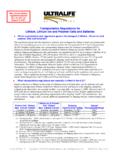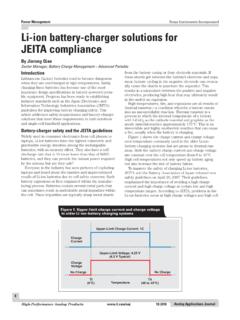Transcription of Ensuring Safety in Battery Pack Assembly - Rose Batteries
1 Katherine Mack, Vice President, Sales & MarketingRose ElectronicsBattery problems can occur at every level of the Battery manufacturing and useprocess. All facets of Battery manufacturing and use must work together for a safe endproduct. Even extensive cell, pack and system testing will not completely prevent anyand all Battery issues from occurring, but it will greatly limit culprit of recent Battery incidents and recalls is wide and varied. Accomplishedmanufacturers of cylindrical 18650-size cells have now produced well over 2 billioncells and are far along the learning curve for producing cells. However, even accom-plished cell and pack manufacturers still experience in-house and field failures. Tocomplicate matters, new players are sprouting up in the lithium ion cell cells and packs are being produced by "beginners" with no experienceand sometimes a disregard for Safety measures due to price reason for recalls at the cell level include issues such as tiny particles gettingcaught in electrode material causing internal cell shorts, and electrode slitters notmaking clean cuts which cause burring on electrode edges resulting in internal shortcircuits.
2 At the pack level, poor Battery design has caused issues in that when a prod-uct is dropped at a certain angle, the Safety devices are compromised. Solder ballshave come loose on Safety boards and caused internal shorts inside packs. At the sys-tem level, charge regimes such as pulse charging of Batteries weaken separator mate-rial in cells and allow internal shorts. In addition, counterfeit cells and packs made toinferior standards (some packs not even containing required Safety devices) haveentered the Battery industry is essentially self-policing. Starting at the cell level, reputablecell manufacturers dictate Assembly procedures to their pack assemblers and approveapplications. However, not all manufacturers share the same philosophy. Recent facto-ry fires and cell shortages have exacerbated the black/gray market cell and adherence to established agency standards such as UL and CSA are rec-ommended, but not absolutely required for most applications.
3 Pass criteria for theseabuse tolerance tests generally revolve around the lack of an explosive or flame eventon a yes/no basis for a defined parameter. Given this, cells and packs can be designedfor the sole purpose of passing a particular test. The only actual requirements for test-ing Battery packs for Safety fall under the UN Transportation guidelines, a systemwhich is, in reality, also self-policing. Ensuring a safe product begins at the cell level and ends with the user. It is aboutunderstanding the intended use of a product, and mitigating reasonable and foresee-able misuse that may occur. IEEE P1625, the Standard for Rechargeable Batteries forPortable Computing, was the first standard to encompass all levels of the Battery man-ufacturing process and include the customer experience. IEEE P1725, the Standardfor Rechargeable Batteries for Cellular Telephones, followed.
4 This graph from therecently updated P1625-2008 standard IEEE illustrates the thought process:In addition, the Japan Electronics and Information Technologies IndustryAssociation (JEITA) and the Battery Association of Japan (BAJ) have also formulateda standard for lithium ion Batteries for notebook computers. Their standard alsoencompasses a holistic approach to designing a successful Battery . Ensuring Safety at the cell level includes the addition of internal vent mechanisms,the use of internal positive temperature coefficients (PTCs), good separator designand a consistent manufacturing process. Testing to and for agency approvals help tomitigate failures as these include testing for overcharge, forced discharge, crush, ther-mal abuse, external and internal short circuit. Testing not only new cells, but cells thathave aged or experienced a number of cycles, helps to eliminate possible field the pack level, the addition of Safety components goes a long way in lesseningrisk.
5 A Safety circuit, protecting packs against overcharge, overdischarge and overcur-rent, is mandatory. A secondary protector, such as a current and/or temperature-basedcomponent (PTC or a thermostat) is absolutely recommended. A thermistor to moni-tor Battery temperature while charging is also desired, especially for NiMHchemistries. For larger packs, a one-shot chemical fuse is suggested. Good manufac-turing practices and good design, such as use of trained operators, the addition ofextra insulation and recessing contacts also add to a pack's Safety rating. Verificationthat Safety devices are actually working packs is also needed: overcharge/overdis-charge, short circuit, continuous charge tests are among industry standard. At system level, the charger is the first line of defense. A charger matched to thespecifications of the Battery is non-negotiable.
6 Different cell chemistries all have theirown recommended charge methodologies. In lithium ion cells, the overcharge condi-tion is the condition in which cells are most volatile. Charge method, voltage, chargerate and temperature all must be considered. Test verification of charger with the bat-tery must be performed. Ensuring that the end unit does not cause any unforeseencurrent spikes or shorts (mechanical or electrical) is compulsory. In addition, the bat-tery must be appropriate for the environment in which it is used. A Battery specifiedto operate in 0 C to 45 C has no business being used where temperatures will beabove or below these levels. The following graph from JEITA/BAJ illustrates thesafety range for voltage for both charge and discharge. All the cell, pack and system testing is for naught, though, if the user does notunderstand or respect the Battery for the high energy system that it is.
7 Shipping issuesand improper packaging have caused the greatest number of single Battery can occur in single shipments, bulk shipments and where Batteries are con-tained in or packed with equipment. Shipping issues are not limited to Battery packs;they can just as easily occur with coin cells or so-called consumer single proper packaging, incidents will occur. The recent harmonization of the DOTwith new requirements from IATA and ICAO mandate specific labeling and testing ofpacks and packaging for Battery shipments. Shipping personnel must be trained, cus-tomers must be educated and regulations must be adhered to. So how to ensure a safe Battery pack? Ensure all levels of Battery manufacturingare addressed: cell, pack, system, user and environment. There is no substitute forusing experienced, high quality, reputable cell and pack vendors.
8 Utilize acceptedindustry practices. Design in early. Don't use price as the lead item. Design and testper industry standards, and perhaps more importantly, test per your applicationrequirements. A holistic approach in designing systems involving Batteries is anabsolutely necessary path for a satisfactory user Mack has more than 20 years of experience in designing and developingcustom Battery systems for industrial and medical OEMs requiring portable has focused her career particularly on portable cell chemistries, cell ven-dors and smart Battery solutions. She was an original member of the IEEE P1625 Working Group for establishing Safety Standards for Mobile Computing. Contact Rose Electronics at a r c h / A p r i l 2 0 0 9 B a t t e r y P o w e r P r o d u c t s & T e c h n o l o g y w w w.
9 B a t t e r y P o w e r O n l i n e . c o m1 0 | B a t t e r y S a f e t yEnsuring Safety in Battery Pack Assembly







